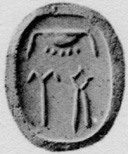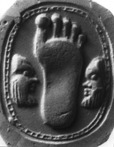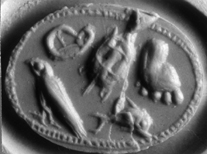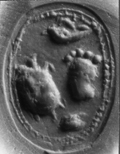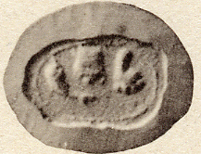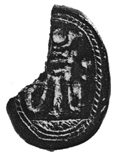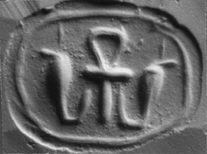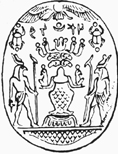I. Mainly Egyptianizing subjects
1. Hieroglyphs and other symbols
A. Hieroglyphs
These copy Egyptian models without understanding them, a common phenomenon in Phoenician art.
West
1/1 Cagliari 21912, from Tharros (Spano). Ebers, pl. F 11; Hölbl, Sard no. 248, pl. 155.1. BL; on a gold hoop C, and with seven gold studs in the back of the scarab. Four registers of hieroglyphs. VI
Click on images to view larger image
East
Other
1/3 London, BM ANE 1954.3-2.2. Hieroglyphs.
No image available
B. Various symbols.
Several have as the main motif versions of familiar Egyptian symbols, but the examples from Tharros which combine tortoise, fish and footprint suggest a purpose which is obscure, though each are found as individual motifs. The footprint alone seems Greek-inspired and is found on classical gems and rings; see Oxford I, no. 71 and references.
West
1/4 Ibiza no. 212 (Madrid 37029). BH. A footprint flanked by two profile satyr heads. I
1/5 Tharros pl. 57a (BM ANE 133165), London no. 430, pl. 7. BH;PB; on a gold hoop. A hawk, murex shell, tortoise, fish and footprint. III
1/6 Tharros pl. 57b (BM ANE 133942), London no. 431, pl. 7. BH;PB. A dolphin, tortoise, footprint and shell (?). III
1/7 Chessa Coll., from Tharros. Ebers, pl. H 83. BL. A tortoise, fish and footprint. III
1/8 From Sulcis, tophet. RSF 1 (1973) pl. 63.9 (Bartolini); Bartolini, no. 123; Hölbl, Sard no. 171, pl. 154.2. BH;EXnb. Hathor-head sistrum with disc and uraei crown, disc-crowned uraei at each side.
East
1/9 Nicosia A.I. 2424, from A. Irini. SCE II, pl.247.3; Reyes, no. 107. BL. Ankh and two uraei.
Other
1/10 Morrison no. 36.2. Four uraei and four cartouches.
No image available
Other materials
1/X1 Once Stosch. AJBA 1 (1968) 75-76, fig. 8 (Culican). Known only from a drawing and a poor impression in Tassie (no. 35). Material? Bottle shaped cross-hatched object on nbw; arms at either side above supporting disc-crowned apes; upon it, four ram heads, four uraei and an atef crown; hawk-headed, double-crowned figures at either side holding ankhs and khnum sceptres; Aramaic inscription above, with disc-and-crescent and between beetles; winged disc above (Persian type with tendrils)




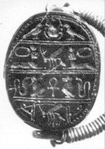
s.jpg)
